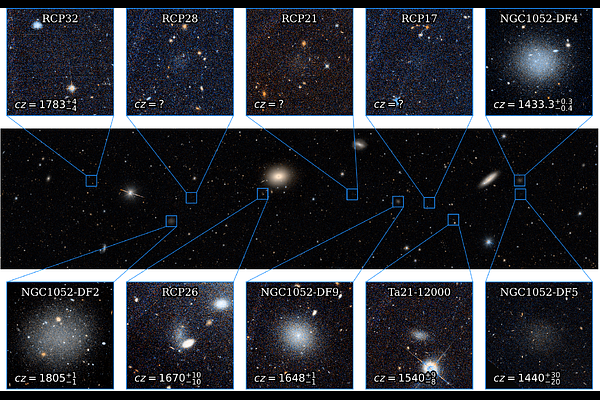Kinematic Confirmation of a Remarkable Linear Trail of Galaxies in the NGC 1052 Field, Consistent with Formation in a High-Speed Bullet Dwarf Collision

Kinematic Confirmation of a Remarkable Linear Trail of Galaxies in the NGC 1052 Field, Consistent with Formation in a High-Speed Bullet Dwarf Collision
Michael A. Keim, Pieter van Dokkum, Zili Shen, Harrison Souchereau, Imad Pasha, Shany Danieli, Roberto Abraham, Aaron J. Romanowsky, Yimeng Tang
AbstractA unique linear trail of diffuse galaxies was recently identified in the NGC 1052 field. This trail includes the remarkable, ultra-diffuse galaxies DF2 and DF4 which lack dark matter and host unusually luminous globular clusters. It has been proposed that the trail formed via a high-speed collision between two gas-rich dwarf galaxies. This scenario predicts that the trail galaxies are kinematically connected and follow a specific trend in radial velocity as a function of position, based on the known velocities and positions of DF2 and DF4. To test this hypothesis, we measured radial velocities for seven additional galaxies on the trail. While the galaxies' low surface brightnesses presented observational challenges, we employ several methods to obtain measurements for galaxies with effective surface brightnesses up to 28.6 mag arcsec$^{-2}$, including a narrow slit placed over globular clusters and a novel wide slit mode on Keck/LRIS, as well as a 'light bucket' mode on Keck/KCWI. We find that five of our seven targets follow the precise velocity trend predicted by DF2 and DF4, to a degree with just a 2% chance of randomly occurring. Moreover, the trail galaxies' radial velocities are significantly higher than those of the NGC 1052 group, setting it apart as a separate, kinematically connected system. Our findings support the theory that this trail of galaxies, including DF2 and DF4, formed together in a single event. A 'bullet dwarf' collision remains the only known explanation for all the unusual properties of DF2, DF4, and the associated trail of galaxies.